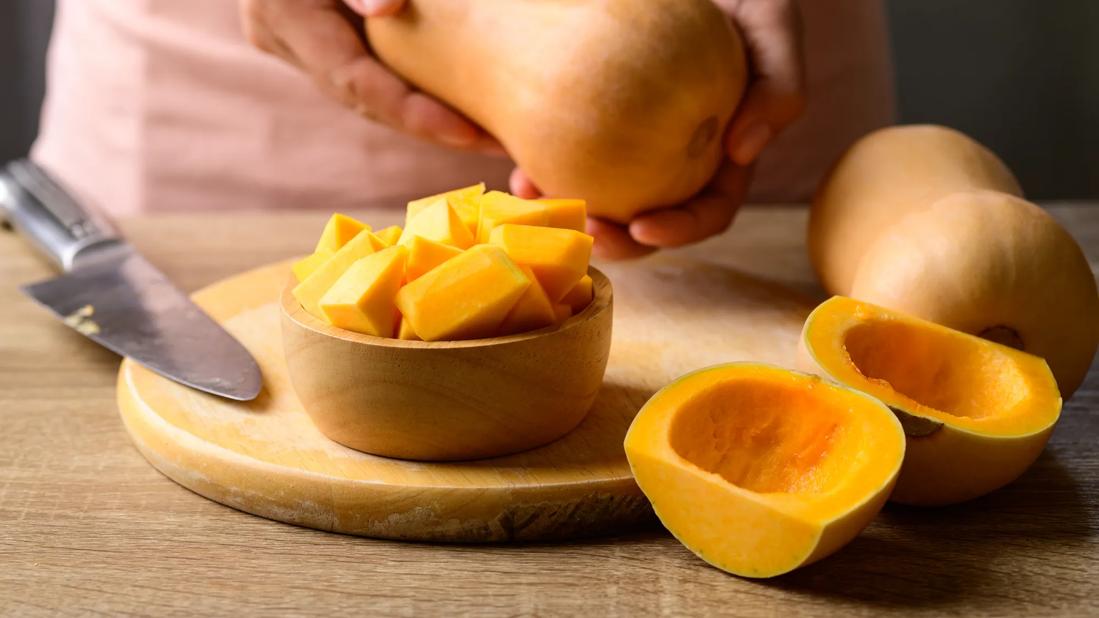High in vitamin A, antioxidants, fiber and potassium, this winter squash helps protect your eyes, heart and gut

Butternut squash is a fall harvest favorite. This curvy, cream-colored fruit (yes, squashes are fruits, not vegetables) has bright orange flesh that tastes even sweeter when roasted or cooked. It also has lots of nutrients that fight disease and promote good health.
Advertisement
Cleveland Clinic is a non-profit academic medical center. Advertising on our site helps support our mission. We do not endorse non-Cleveland Clinic products or services. Policy
One cup (or 140 grams) of raw, cubed butternut squash has approximately:
It also provides these nutrients:
Squash is naturally free of cholesterol and gluten, says registered dietitian Julia Zumpano, RD, LD. Plus, it’s low in fat and carbs, making it a low glycemic index food. Butternut squash has nutrients, antioxidants and fiber that provide a host of health benefits.
Butternut squash is one of the best foods for eye health, thanks to a few natural plant pigments called carotenoids.
Beta-carotene gives the flesh its vibrant orange color. Your body changes beta-carotene into vitamin A, an essential nutrient that promotes healthy vision. Depending on your age and sex, a cup of butternut squash provides up to half the vitamin A your body needs every day.
Butternut squash also has lutein and zeaxanthin. A review of studies found that these carotenoids minimize damage from ultraviolet (UV) light from the sun and blue light exposure from screens.
Advertisement
Butternut squash also has vitamin C. Together with vitamin A and carotenoids, these powerful nutrients help prevent or slow age-related vision problems, such as cataracts and macular degeneration.
Butternut squash has plenty of vitamins A, C and E, which all provide antioxidant benefits.
“Antioxidants protect your body from free radicals — unstable molecules that change or damage your cells,” says Zumpano.
When free radicals outnumber antioxidants, oxidative stress occurs. Studies show that oxidative stress increases the risk of chronic diseases. But eating more butternut squash may help lower your risk of:
One cup of butternut squash has 7% to 10% of the fiber you need each day, depending on your age and sex. That includes both types of fiber:
Because fiber is filling, eating butternut squash can stave off hunger pangs and aid weight loss. High-fiber foods also:
One cup of raw butternut squash has more potassium than a banana, making it an excellent potassium-rich food choice. This winter squash is also a good source of magnesium. Both minerals support heart health and reduce your risk of heart disease.
Other ways these micronutrients protect your heart:
Butternut squash is great for your health and taste buds. But it can have unusual effects on your skin.
A small number of people have an allergic skin reaction to a chemical compound in the flesh of raw butternut squash. Experts are still trying to figure out what that chemical is.
Known as contact dermatitis, this reaction causes an itchy rash on skin that comes into direct contact with the allergen. It’s known as “squash hands” because the rash appears after your hands touch raw squash. You may also have a tingling, burning sensation. And the skin on the affected hand may become dry and flaky.
“This allergic reaction is unpleasant but not life-threatening,” says Zumpano. “An over-the-counter hydrocortisone cream can help.”
Advertisement
Other plants in the Cucurbitaceae plant family, such as pumpkins, watermelons and zucchinis, can also cause this skin reaction. But butternut squash and other plants of the Cucurbita moschata variety are the worst culprits.
Fortunately, having a skin reaction to butternut squash isn’t the same as having a food allergy.
“People with squash hands can safely handle and eat butternut squash,” she clarifies. “But they should wear food-grade gloves when touching raw squash.”
You could also let someone else do the work and/or buy precut squash instead.
People who overly enjoy butternut squash and other orange foods like carrots may get too much beta-carotene. While this isn’t bad for your health, it can give a yellow-orange tint to the skin on your palms, soles, nose and laugh lines.
This harmless skin condition is called carotenoderma. Cutting back on vitamin A-rich foods and supplements can return your skin to its usual tone — but if you don’t cut back, the yellow tint can gradually affect your entire body.
Butternut squash is extremely versatile, perfect for roasting and sautéing or using in purees or soups. Enjoy these 11 different ways to savor the sweetness of this winter squash.
Advertisement
Advertisement
Learn more about our editorial process.
Advertisement

The small red fruit is a good source of potassium and vitamin C — and may support your gut and brain health

This fruit has clear nutritional benefits — but there’s little evidence it can prevent or treat illness

The tropical fruit is a good source of fiber and antioxidants and may help reduce inflammation

Oranges, grapefruits, lemons, limes and other citrus fruits have nutrients that help support immune system, heart and gut health

This glorious green superfood is full of vitamins, minerals and lots of other healthy stuff

High in antioxidants, this superfood offers many health benefits, including improving digestion and lowering cholesterol

Coconut is a good source of healthy fat, fiber and essential minerals like manganese

The best parenting style balances enforcing rules and showing plenty of love

Tips include cutting back on sugar, focusing on exercise and managing stress

It can be harder to let go when you’ve invested time, energy and emotions — but it might be the healthier choice long term